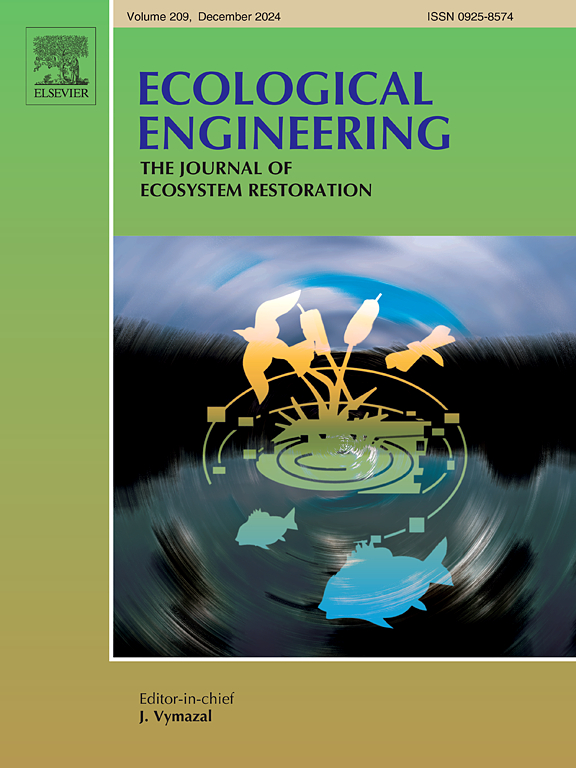硅藻定殖和生物膜金属生物积累:本土知识系统能帮助城市海岸线的生态工程吗?
IF 4.1
2区 环境科学与生态学
Q1 ECOLOGY
引用次数: 0
摘要
海洋工程结构改变了沿海生态系统的功能,用平坦的表面取代了自然基质,往往对生物多样性产生负面影响。在提供海岸保护的同时,人工结构可能会阻碍生物膜的初始定植和海岸物种的补充。通过基于自然的干预措施绿化灰色基础设施越来越多地用于增强人工结构的生物多样性。本研究探讨了莎草莎草纺织品及其土著知识应用的潜力,作为南非东南沿海城市化地区沿海生态工程的基础。对部署的试用版设计(imizi结构)上的硅藻演替和金属生物积累进行了为期一个月的监测,并在部署后6、12、24、72小时、1、2周和1个月采集样本。对基质附近的水质,包括溶解的营养物和金属浓度进行了评估。结果表明,硅藻在12小时内就开始定殖,最初的种类包括碎藻(Fragilaria pulchella)、新碎藻(Neofragilaria nicobarica)、Navicula sp.和波状藻(Grammatophora波动),一周后物种多样性显著增加(4.6倍),从5种增加到23种。在基质上发育的生物膜中,铝、铁、锌、锰和砷的生物积累量高于其周围环境(米子基质和水),表明生物膜在天然基材料上具有潜在的生物修复能力。这些发现表明,在沿海生态工程实践中,利用本土知识为基础的材料作为初级生产力的促进剂具有潜在的适用性,此外,纺织草还具有对砷等有毒金属进行生物修复的潜力。本文章由计算机程序翻译,如有差异,请以英文原文为准。

Diatom colonisation and biofilm metal bioaccumulation: Can Indigenous Knowledge Systems aid the ecological engineering of urban coastlines?
Marine engineered structures alter the coastal ecosystems' functionality, replacing natural substrates with flat surfaces, often negatively impacting biodiversity. While providing coastal protection, artificial structures can hinder the initial colonisation by biofilm and the recruitment of coastal species. Greening the grey infrastructure through nature-based interventions is increasingly used to enhance biodiversity in artificial structures. This study explores the potential of the sedge Cyperus textilis and its Indigenous Knowledge applications as a substrate for coastal eco-engineering at an urbanised site on the southeast coast of South Africa. Diatom succession and metal bioaccumulation on the deployed trial-version designs (imizi structures) were monitored for a month, with samples collected at six, twelve, twenty-four, seventy-two hours, one and two weeks, and one month after deployment. Water quality, including dissolved nutrients and metal concentrations, were assessed near the substrates. Findings indicated that diatom colonisation occurred within twelve hours, with initial species including Fragilaria pulchella, Neofragilaria nicobarica, Navicula sp. and Grammatophora undulata, followed by a significant increase (4.6 times) in species diversity from 5 to 23 diatoms after one week. Metal bioaccumulation of aluminium, iron, zinc, manganese and arsenic was higher in the biofilm developing on the substrate compared to its surrounding environment (imizi substrate and water), suggesting the potential bioremediating capabilities of the biofilm on the nature-based material. These findings indicate the potential suitability of using Indigenous Knowledge-based materials for coastal eco-engineering practices as promoters of primary productivity, with the added potential of the plant C. textilis for bioremediation of toxic metals such as arsenic.
求助全文
通过发布文献求助,成功后即可免费获取论文全文。
去求助
来源期刊

Ecological Engineering
环境科学-工程:环境
CiteScore
8.00
自引率
5.30%
发文量
293
审稿时长
57 days
期刊介绍:
Ecological engineering has been defined as the design of ecosystems for the mutual benefit of humans and nature. The journal is meant for ecologists who, because of their research interests or occupation, are involved in designing, monitoring, or restoring ecosystems, and can serve as a bridge between ecologists and engineers.
Specific topics covered in the journal include: habitat reconstruction; ecotechnology; synthetic ecology; bioengineering; restoration ecology; ecology conservation; ecosystem rehabilitation; stream and river restoration; reclamation ecology; non-renewable resource conservation. Descriptions of specific applications of ecological engineering are acceptable only when situated within context of adding novelty to current research and emphasizing ecosystem restoration. We do not accept purely descriptive reports on ecosystem structures (such as vegetation surveys), purely physical assessment of materials that can be used for ecological restoration, small-model studies carried out in the laboratory or greenhouse with artificial (waste)water or crop studies, or case studies on conventional wastewater treatment and eutrophication that do not offer an ecosystem restoration approach within the paper.
 求助内容:
求助内容: 应助结果提醒方式:
应助结果提醒方式:


